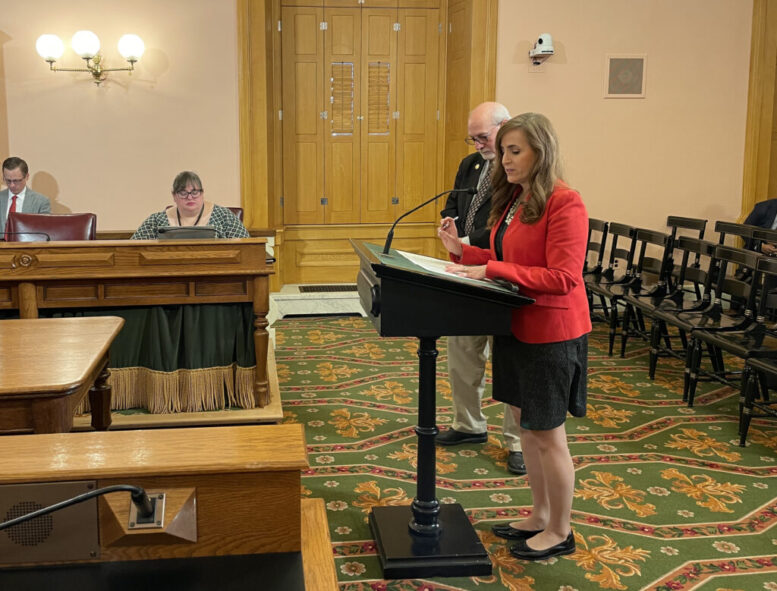BY NICK EVANS
A Senate committee heard from supporters last week of a measure effectively banning ranked choice voting in the state. The measure is bipartisan — proposed by Sens. Theresa Gavarone, R-Bowling Green, and Bill DeMora, D-Columbus. But its public backers so far are mostly conservative and right-wing groups.
Only three organizations showed up in person — Opportunity Solutions Project, The Heartland Institute and The Honest Elections Project. But the Trump-aligned administration in-waiting, America First Policy Institute, submitted written testimony as did the Heritage Foundation.
Notably, no local governments in the state currently use ranked choice for their elections. Although a handful of Ohio cities used it briefly in the early 1900s, there’s no groundswell of local elected leaders calling for its return.
[RELATED: How a new way to vote is gaining traction in states — and could transform US politics]
Under the Senate proposal, any municipality that did so would lose its share of the local government fund — a vital source of revenue.
Who showed up?
Opportunity Solutions Project got bashed last year when it was the sole advocate to show up on behalf of HJR 6. That measure was the first attempt to raise the threshold for state constitutional amendments, which sponsors argued was necessary to keep “out of state interests” from the gaming the process.
Opportunity Solutions Project is based in Florida.
The organization has lobbied for electoral changes in several states, especially in the wake of former President Trump’s false claims of a stolen election. Frank Strigari, the state Senate’s former chief counsel, spoke on their behalf. He argued “this is not really truly a one-side issue when it comes to partisanship,” after citing Democratic and Republican-led governments that have opposed the approach. Strigari added that ranked choice leads to votes being “thrown in the garbage.”
This claim, however, is disingenuous. Ranked choice removes the lowest placed candidate in successive rounds. Voters who backed that candidate would then see their votes applied to their next highest choice.
If, for instance, a voter made two selections, but the tallying went through three rounds and their picks are no longer in the race, their ballot is “exhausted.” That is to say, although it was counted, it no longer has an impact on the tally. To say that ballot was “thrown in the garbage” is about the same as saying any vote cast for a candidate other than the eventual top two finishers is wasted.
Cameron Sholty, from Heartland Impact, argued “it’s important to understand that this is not just an Ohio challenge. This is not just a solution in search of a problem. It is actually a solution to combat, and to counter, in fact, a very real problem.”
Instead of citing a single Ohio example, however, Sholty described efforts in other states including Missouri and Wisconsin. His organization is part of the Heartland Institute, which made a name for itself sowing doubt about climate change and the link between smoking and cancer.
Jason Snead’s Honest Elections Project is a business alias for The 85 Fund, a Leonard Leo-connected non-profit that spends heavily on conservative causes. He argued multiple rounds of tallying open more opportunities for legal challenges. Snead also noted a more complex ballot will make recounts more time consuming.
But argued ranked choice voting threatens “the American tradition of one person, one vote,” but then went on to discount the validity of those voters’ choices.
“It is dubious to say that a candidate who wins by redistributing votes truly enjoys majority support,” he argued. “There’s clearly a difference between a first and a third-place pick. To a voter the latter may signify indifference to a candidate, outright opposition, or it may signify nothing at all.”
How advocates respond
Although there aren’t any Ohio cities pushing for ranked choice, grass roots groups are organizing around the issue. Rank the Vote Ohio is the state chapter of an organization pushing for ranked choice voting in 29 states.
By letting voters express support for more than one candidate, the group contends, they’re less likely to compromise — casting votes for a candidate who isn’t their top choice because that candidate is unlikely to win. Those concerns about a “spoiler” candidate dramatically reduce the potential impact of independent and third-party candidates. In response, Rank the Vote believes candidates will emphasize broad appeal in their campaigns, rather than divisive rhetoric.
Rank the Vote Ohio director Kyle Herman adds the proposed legislation tramples on constitutional ‘home rule’ authority, “which empowers local governments to make decisions based on their local needs instead of a one-size-fits-all approach dictated by the state.”
“This is why the Ohio Supreme Court ruled in 1923 that Ohio cities have a constitutional right to use ranked choice voting,” he added in reference to the case Reutener v. City of Cleveland.
While Rank the Vote Ohio is itself part of a multi-state organization, he dismissed the Senate bill’s supporters as “out of state lobbyists,” and argued they’re “part of a national front that is trying to undermine election integrity by suppressing voters’ choices and subverting majority rule.”





